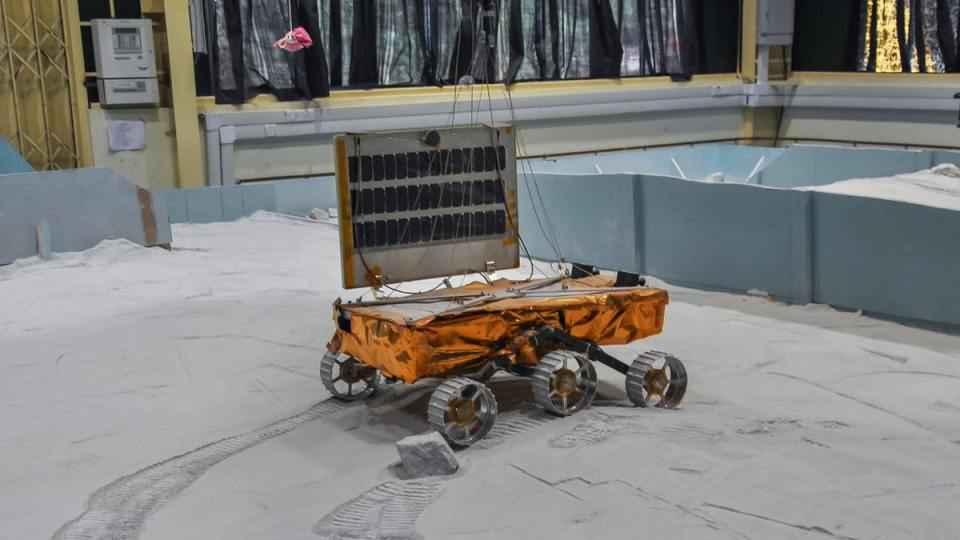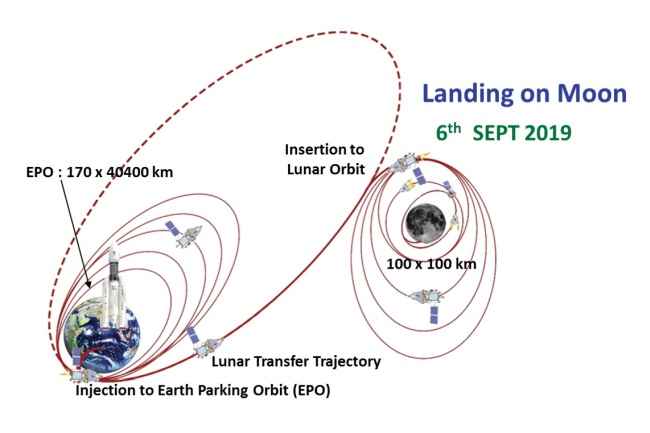Everything you need to know about Chandrayaan 2 – India’s follow up mission to the moon

On June 13, Dr K Sivan, Chairman of ISRO met with the press to announce more details about the next milestone mission for the Indian space program, Chandrayaan 2. The mission has been scheduled for a July 15 launch, at 2:51 AM in the morning.
The mission has been in planning for an incredibly long duration. The Chandrayaan 2 mission was approved in 2008, even before Chandrayaan was launched. Initially targeted for the first quarter of 2018, ISRO deliberately delayed the launch of the Chandrayaan-2 mission to make sure that they got the mission right, without rushing through the preparation.
Mission Profile
There are three components on the mission. The lander is stacked above the orbiter within the rocket. The orbiter weighs 2,379 kg, and is capable of communicating with the lander as well as the Indian Deep Space Network (IDSN) facilities near Bengaluru. The lander is named Vikram in honour of Dr Vikram Sarabhai, the founder of the Indian space program. The lander can communicate with the rover, the orbiter, and the IDSN facility. The lander has a planned mission duration of 1 lunar day, or 14 Earth days. The lander weighs 1,471 kg, and has the rover nested within it. The rover is named Pragyan (which means wisdom in Sanskrit), weighs 27 kg and is the lightest component on the mission. The rover generates electricity using a solar panel, has six wheels, and can only communicate with the lander. All the three components stacked together form a composite body, that are located in the heat shield or payload fairing of the GSLV MK III rocket, India’s most powerful launch vehicle, and one that has been entirely designed and fabricated within the country.
The launch will take place from the Sriharikota High Altitude Range (SHAR), India’s launch complex. Initially the composite payload will be deployed into an Earth parking 170×40400 km orbit. Over a period of the next 16 days, the altitude of the composite body will be increased five times, using on board thrusters. On the 16th day, ISRO will execute a maneuver called trans lunar injection, where the spacecraft jumps from an Earth orbit to the Moon. The Chandrayaan 2 mission will take five days to make the hop from the Earth to the Moon. At the end of the period, the thrusters will be fired again to inject the spacecraft into an orbit around the Moon. Over the course of the next 27 days, the on board propulsion systems will fire continuously, to reduce the altitude of the lunar orbit, down to a circular orbit of 100×100 km. The orbiter will be used to survey the landing site near the south pole of the Moon, before it separates from the lander.
Then comes the really tricky part. The lander has to break away from the orbiter, and execute a soft landing on the Moon. It has to shed all its velocity in less than fifteen minutes. K Sivan described the stage of the operation as, “these fifteen minutes are going to be the most terrifying for all the people who belong to ISRO, probably for the scientists and the people in India also. This is going to be the most difficult task ever undertaken by ISRO in a mission.” This is a technically more advanced operation than previous mission. The lander in Chandrayaan crashed into the Moon. The algorithms for executing the soft landing have been developed entirely in house, so the landing itself is a demonstration of the technical prowess of Indian scientists. During the touchdown, the lander will extend legs to dampen the landing, and protect the delicate electronic components on board. ISRO has tested the operations of the lander at a special facility built for that purpose near Chitradurga. If successful, the soft landing will be the first near the south pole of the Moon, and India will become the fourth country to execute such a landing. After the landing, the rover will be slowly deployed over the course of four hours. The rover will then explore the lunar surface, and has a maximum range of 500 meters. The rover is semi-autonomous, and will be receiving partial control commands from the ground station. ISRO created artificial lunar soil to test the rover and make sure that it works as expected.
The Mission Profile
Image credit: ISRO
Payloads and Objectives
At this point, the mission will have already achieved its primary goal, which is to demonstrate the capabilities of soft landing on the lunar surface, and operating a rover on the surface. However, on board the lander, rover and the orbiter are a number of scientific payloads, that will study the region.
The instruments that will facilitate all these experiments were designed, developed and made by various ISRO facilities located all across India. These include the Space Application Centre (SAC) in Ahmedabad, the Space Physics Laboratory (SPL) in Thiruvananthapuram, and the Space Astronomy Group (SAG) in Bengaluru. The Terrain Mapping Camera 2 (TMC2) on board the orbiter will take sub 5 m resolution images of the lunar surface, and will allow ISRO scientists to create 3D maps. The Chandrayaan 2 Large Area Soft X-Ray Spectrometer (CLASS) will examine the presence and distribution of rock forming elements such as Magnesium, Aluminium, Silicon, Calcium, Titanium, Iron, and Sodium. These elements will be identified based on the characteristic emissions when exposed to sunlight. Supporting the CLASS instrument will be the Solar X-Ray Monitor (SXM), which measures the intensity of solar radiation, so that the observations and measurements from CLASS can be accurately calibrated. The Orbiter High Resolution Camera (OHRC) will be used to identify the landing area, and generate 3D maps to ensure that the lander performs as expected. The Imaging Infrared Spectrometer (IIRS) will be used for mapping the distribution of minerals and finding water or hydroxyls. The Dual Frequency Synthetic Aperture Radar will be used to map the polar regions, measure the thickness of the regolith (dry soil) on the lunar surface and estimate the quantity of water ice in the polar regions. The Chandrayaan 2 Atmospheric Compositional Explorer 2 (CHACE2) will continue the measurements of the Chandrayaan mission, and study the rarified exosphere of the already tenuous lunar atmosphere. Finally, the Dual Frequency Radio Science (DFRS) experiment will measure the electron density in the ionosphere of the Moon. Two other instruments developed for the mission, the Chandrayaan Surface Thermophysical Experiment (ChaSTE) and the Radio Anatomy of Moon Bound Hyper-Sensitive Atmosphere and Ionosphere (RAMBHA) payloads, are on the Vikram lander.
Broadly speaking, all the three components of the mission hope to conduct topological and mineralogical studies of the lunar south pole. The data from these observations will be made available to the Indian scientific community. If the Chandrayaan mission is anything to go by, the observations by Chandrayaan 2 will continue to form the basis of new research long after the planned mission duration of 1 year.
Main image: The Pragyaan Rover, image credits: ISRO
Aditya Madanapalle
Aditya Madanapalle, has studied journalism, multimedia technologies and ancient runes, used to make the covermount DVDs when they were still a thing, but now focuses on the science stories and features. View Full Profile






